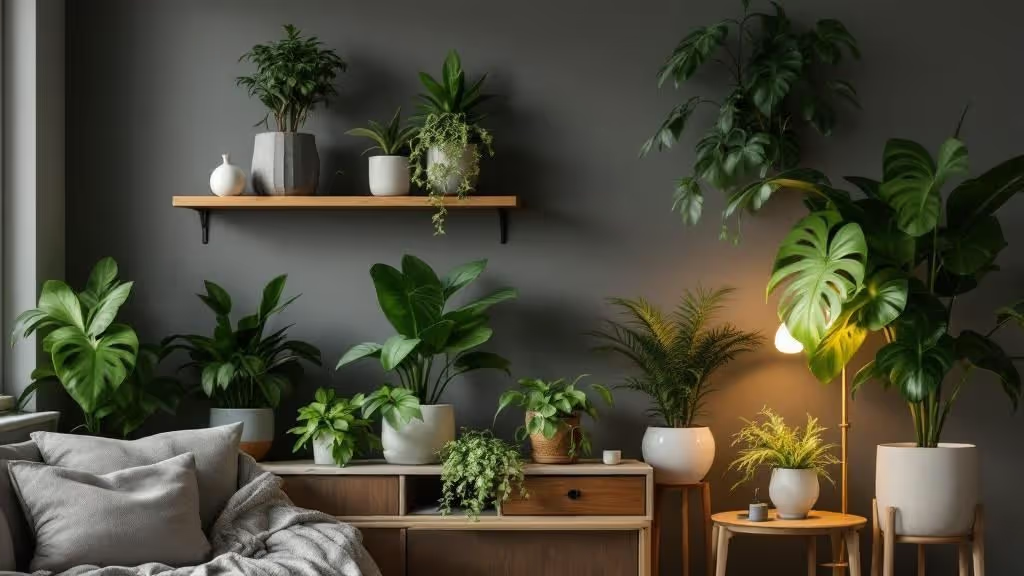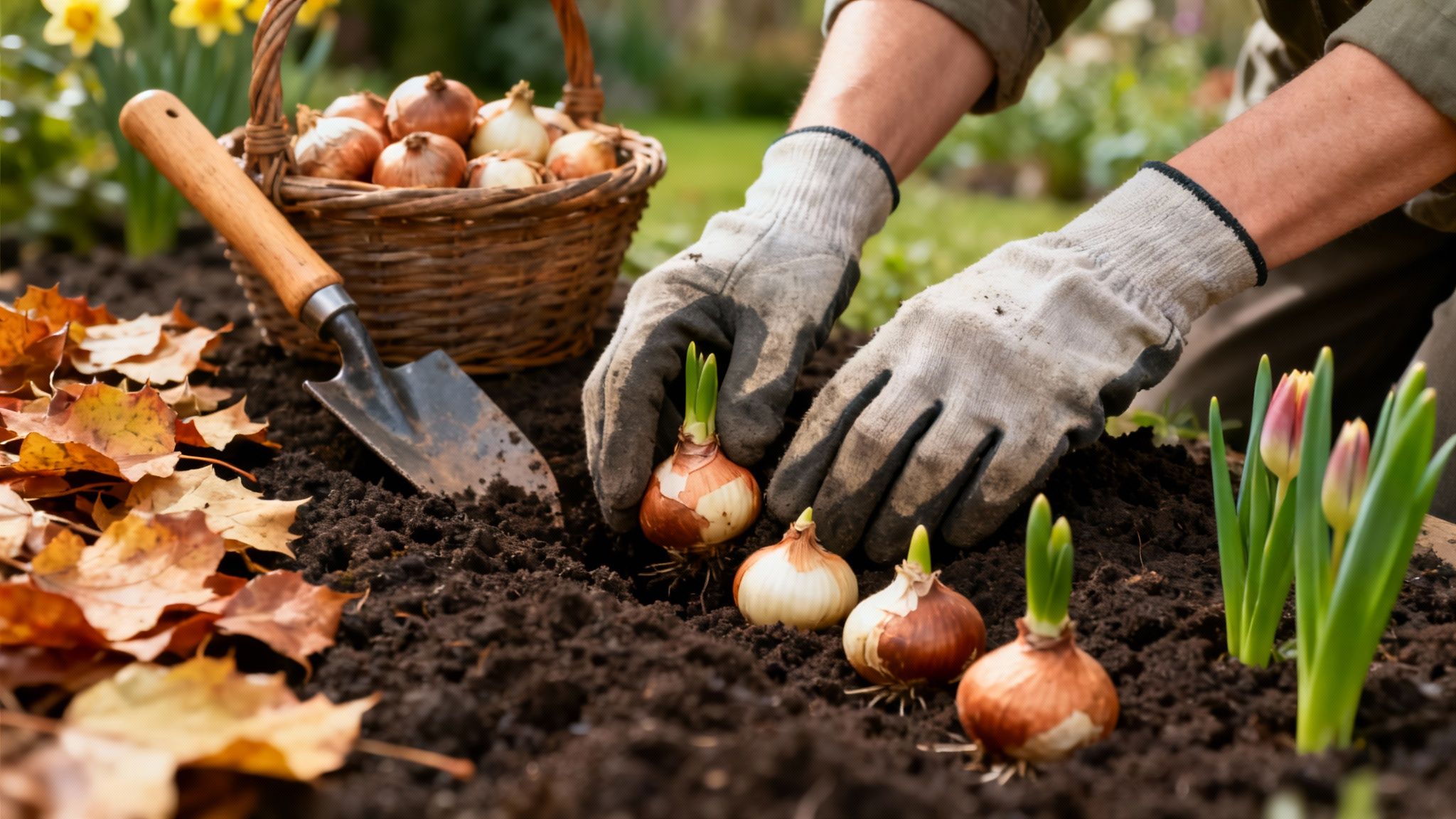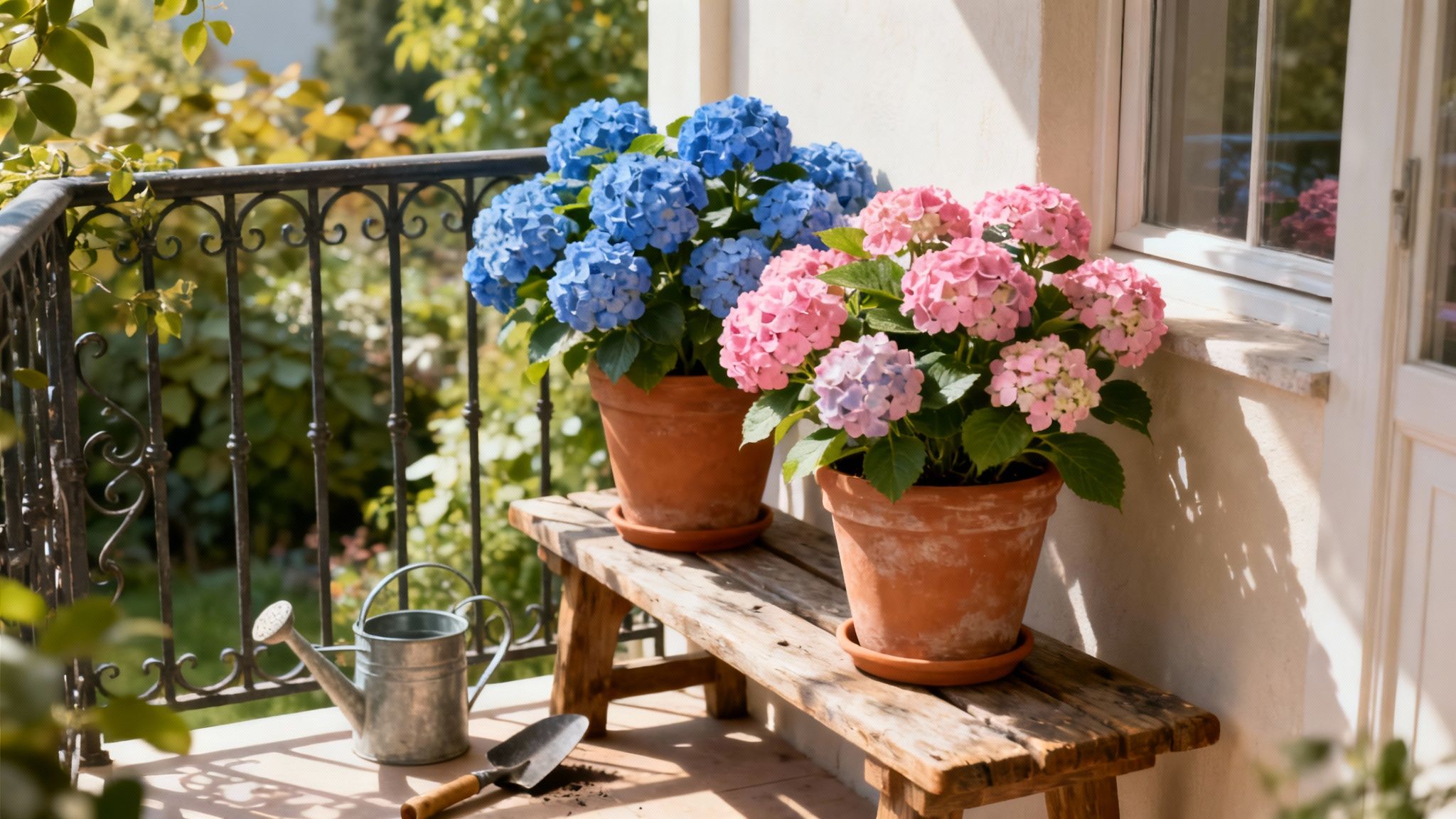Every home has them: the north-facing room, the poorly lit hallway, or the office corner far from any window. These spaces can often feel lifeless and neglected, but they don't have to stay that way. Choosing the right houseplants can introduce colour, texture, and a touch of nature to even the most light-deprived areas, transforming them into calming sanctuaries.
This guide is dedicated to exploring the hardiest and most beautiful low-light champions of the plant world. Forget the myth that you need bright, sunny windowsills for a thriving indoor garden. We will delve into a curated selection of the best plants for dark rooms, providing you with a comprehensive resource to confidently select, place, and care for each one.
You'll discover a variety of options, from the architecturally striking Snake Plant to the gracefully trailing Pothos. We'll provide practical, real-world advice on care specifics, common pitfalls to avoid, and ideal placements to ensure your new green additions don't just survive, but truly flourish. It's time to embrace the shadows and let every corner of your home thrive.
1. Snake Plant (Sansevieria trifasciata)
Often called Mother-in-Law’s Tongue, the Snake Plant is a champion of resilience and arguably one of the best plants for dark rooms available. Its architectural, sword-like leaves stand tall, creating a strong vertical element that suits modern and minimalist décor. While many houseplants struggle without bright, indirect sunlight, the Sansevieria is exceptionally tolerant of low-light conditions, making it a reliable choice for areas where other plants would fail. It thrives on neglect, which is a major advantage for busy homeowners or those new to plant care.
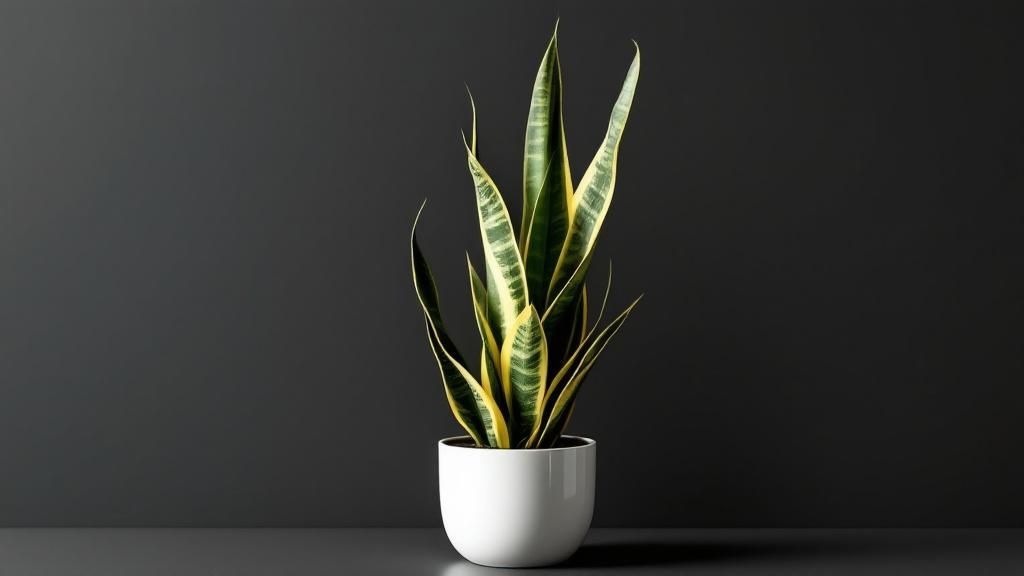
This plant's ability to survive in near-darkness has made it a staple in commercial settings. You'll often see it adding a touch of green to corporate office corridors with no windows, hotel lobbies, and even dimly lit bathrooms. Its dramatic appearance and minimal needs make it a designer's go-to for adding life without the maintenance burden. This plant’s hardiness is a key reason it remains one of the top indoor plant choices, a trend that is set to continue as noted in recent gardening discussions. You can explore more about its place in upcoming décor trends in the 2025 garden trends on Spruce Collective.
Why It Works for Dark Rooms
The Snake Plant’s secret lies in its Crassulacean Acid Metabolism (CAM) photosynthesis. Unlike most plants, it opens its stomata (leaf pores) at night to exchange gases, which minimises water loss in its native arid environments. This adaptation also makes it highly efficient in low light, as it can store carbon dioxide overnight and photosynthesise with whatever minimal light it receives during the day.
Key Benefit: Beyond its tolerance for darkness, the Snake Plant is celebrated for its air-purifying qualities. It was featured in NASA's Clean Air Study for its ability to filter indoor air and remove toxins like formaldehyde and benzene.
Practical Care and Implementation Tips
- Watering Wisely: The most common mistake is overwatering. Allow the soil to dry out completely between waterings, typically every 2-6 weeks. In very low light, it may need even less.
- Proper Potting: Use a well-draining cactus or succulent soil mix. Ensure your pot has drainage holes to prevent root rot, the Snake Plant's primary enemy.
- Light Placement: While it tolerates darkness, it will grow more actively with some light. Placing it near an artificial light source or in a room with a north-facing window is ideal.
- Keep it Clean: Dust can settle on its broad leaves, hindering photosynthesis. Gently wipe them with a damp cloth every month to keep them healthy and vibrant.
2. ZZ Plant (Zamioculcas zamiifolia)
The ZZ Plant is a stunning tropical perennial, instantly recognisable by its waxy, dark green leaves that grow in a graceful, wand-like fashion. It has soared in popularity, especially among those looking for the best plants for dark rooms, due to its remarkable tolerance for low light and drought. Its almost-perfect, glossy foliage gives it an artificial appearance, yet it brings an authentic touch of nature to any indoor space. The ZZ Plant is the definition of a low-maintenance companion, making it ideal for novice plant parents or anyone with a busy lifestyle.
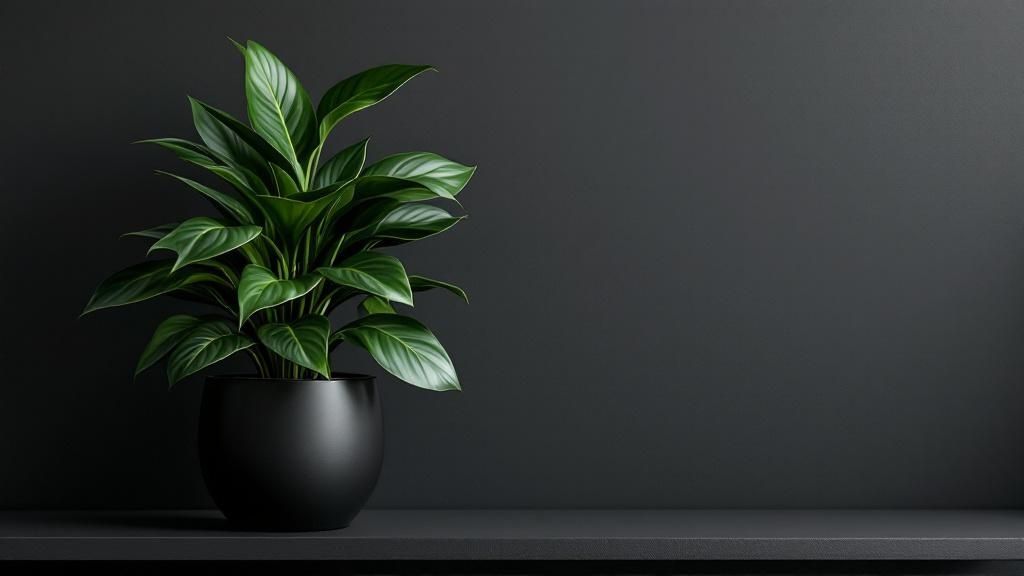
This plant’s architectural form and minimal care requirements have made it a favourite for interior designers and plant influencers alike. You’ll often spot it enhancing the aesthetic of modern office buildings, co-working spaces, and dimly lit apartment living rooms. Its ability to thrive under fluorescent lights makes it a common choice for commercial interiors like hotels and restaurants, where it adds a splash of vibrant green without demanding constant attention. Its resilience and striking look secure its position as a top-tier houseplant for almost any setting.
Why It Works for Dark Rooms
The ZZ Plant’s secret to survival lies underground in its large, potato-like rhizomes. These rhizomes store water, allowing the plant to withstand long periods of drought and neglect. This water-storing capacity means it doesn't need to work hard to find moisture, enabling it to focus its energy on surviving in lower light conditions. It photosynthesises efficiently, making the most of any available ambient or artificial light to maintain its lush appearance without becoming leggy or pale.
Key Benefit: The ZZ Plant is exceptionally forgiving. Its robust rhizome system means it can bounce back from infrequent watering, a common issue for plant owners. This makes it one of the hardiest and most reliable choices available.
Practical Care and Implementation Tips
- Watering Wisely: This plant is more likely to suffer from overwatering than underwatering. Allow the soil to dry out completely before watering again, roughly every 3-4 weeks. Reduce frequency in very low-light areas.
- Proper Potting: Use a well-draining potting mix, such as one designed for cacti or aroids. A pot with ample drainage holes is crucial to prevent the rhizomes from rotting.
- Light Placement: It excels in low to medium indirect light. A spot several feet from a north-facing window or in a room with only artificial lighting is perfectly suitable.
- Keep it Clean: The glossy leaves can accumulate dust, which can block light absorption. Wipe them gently with a damp cloth every few months to keep them looking their best and functioning efficiently.
3. Pothos (Epipremnum aureum)
Affectionately known as Devil’s Ivy, Pothos is a versatile and nearly foolproof houseplant, celebrated for its forgiving nature. Its lush, trailing vines feature heart-shaped leaves, often showcasing beautiful variegation in shades of green, yellow, or white. This incredible adaptability allows it to thrive in a wide spectrum of light conditions, solidifying its reputation as one of the best plants for dark rooms. Its easy-going attitude makes it a staple for both novice plant parents and seasoned horticulturalists.
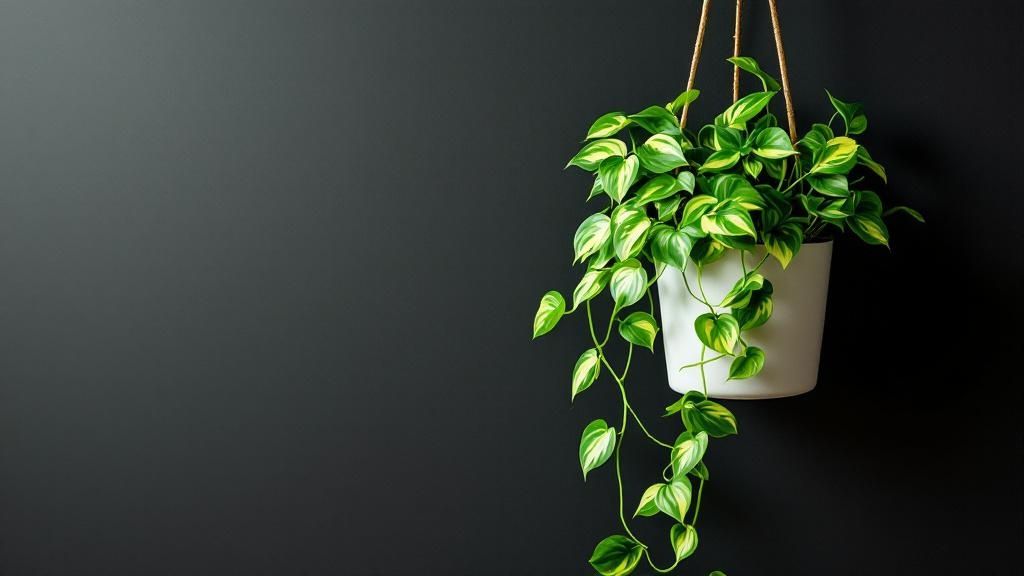
The Pothos is a common sight in various settings, from adding a splash of green to office cubicles and conference rooms to softening the aesthetic of hotel lobbies. Its tolerance for humidity also makes it a perfect candidate for bathrooms. The cascading vines are frequently used in vertical gardens or styled to trail from high shelves, adding dynamic visual interest. Its hardiness is a significant reason it's so beloved; for those just starting their indoor gardening journey, you can learn more about its simple requirements and other beginner-friendly options in this guide to indoor plants for beginners.
Why It Works for Dark Rooms
Pothos is exceptionally efficient at photosynthesis and can make do with minimal ambient light. While bright, indirect light encourages more robust growth and pronounced variegation, its fundamental ability to survive and even grow in low-light environments is what makes it so valuable. The plant will adapt its leaf production to the available light, continuing to put out new growth even in a dimly lit corner of a room, though the growth may be slower and less variegated.
Key Benefit: Pothos is famously easy to propagate. A simple cutting placed in a glass of water will readily develop roots, allowing you to create new plants for free to share with friends or to make your original plant look fuller.
Practical Care and Implementation Tips
- Watering Wisely: Let the top inch or two of soil dry out completely before watering. Pothos is more tolerant of underwatering than overwatering, which can lead to root rot.
- Encourage Fullness: To prevent the vines from becoming long and "leggy," pinch back the stems regularly. This encourages the plant to branch out, creating a fuller, more bushy appearance.
- Placement Strategy: While it survives in the dark, rotating the plant occasionally ensures all sides get some light exposure for more even growth. Note that highly variegated cultivars may lose some of their colouring in very low light.
- Support for Climbing: If you prefer a vertical look, provide a moss pole or a small trellis. The Pothos will naturally begin to climb, developing larger leaves as it matures.
4. Chinese Evergreen (Aglaonema)
The Chinese Evergreen is prized for its lush, beautifully patterned foliage, making it one of the most decorative and best plants for dark rooms. Its leaves showcase an incredible variety of colours and patterns, from deep greens with silver streaks to vibrant shades of pink, red, and cream. This slow-growing plant is exceptionally forgiving of low-light conditions, making it a stellar choice for adding a touch of the tropics to corners of your home where sunlight is scarce. It’s an easy-care favourite for both new and experienced plant owners.
This plant's robustness in low light has made it a staple for interior landscapers. You'll frequently see it thriving in the planters of shopping centres, adding sophisticated greenery to hotel lobbies, and brightening up dimly lit office spaces. Its striking appearance and minimal light requirements make it a designer's top pick for injecting life and colour into a space without demanding much in return. The newer, more colourful cultivars often require slightly more light to maintain their vibrancy, but the classic green varieties are true low-light champions.
Why It Works for Dark Rooms
Native to the shaded, humid floors of tropical forests in Asia, the Aglaonema is naturally adapted to thrive with minimal sunlight. Its broad leaves are efficient at capturing whatever ambient light is available, allowing it to photosynthesise effectively even in poorly lit environments. This inherent adaptation means it doesn't just survive in the dark; it can maintain its lush appearance and continue to grow, albeit slowly.
Key Benefit: The Chinese Evergreen is known for its ability to tolerate human error. It is quite forgiving if you forget a watering and is generally resistant to common houseplant pests, making it a low-stress, high-reward option.
Practical Care and Implementation Tips
- Watering Wisely: Aim to keep the soil consistently moist but never waterlogged. Allow the top inch or two of soil to dry out before watering again. Using filtered or room-temperature water can help prevent leaf tip burn.
- Proper Potting: A standard, well-draining potting mix is perfect. Ensure the pot has good drainage to avoid root rot, which is a primary risk for this plant if overwatered.
- Light Placement: It performs best in low to medium indirect light. A spot near a north-facing window or several feet away from an east-facing window is ideal. Avoid direct sunlight, which will scorch its leaves.
- Maintain Humidity: As a tropical native, it appreciates higher humidity. Misting the leaves occasionally or placing it near a humidifier will keep it happy, especially during dry winter months.
5. Peace Lily (Spathiphyllum)
The Peace Lily is celebrated for bringing a touch of elegance to shaded corners with its glossy, dark green leaves and iconic white blooms. Its graceful appearance belies its tough nature, making it one of the most popular and best plants for dark rooms. Unlike many flowering plants that demand abundant sunlight, the Spathiphyllum can produce its signature white spathes even in low-light environments, offering a rare splash of colour where other plants might only offer foliage. This combination of beauty and resilience makes it a fantastic choice for both novice and experienced plant owners.
You will often find the Peace Lily lending a serene and sophisticated atmosphere to spaces like spa reception areas, medical waiting rooms, and home offices where natural light is limited. Its lush foliage and calming presence contribute significantly to a tranquil environment, which is why it's a staple for creating inviting interiors. The plant's ability to thrive indoors helps create a sense of wellbeing, a key element explored in guides on how to make a room cosy. Its enduring popularity is a testament to its easy-care reputation and stunning looks.
Why It Works for Dark Rooms
The Peace Lily's large, broad leaves are highly efficient at capturing what little light is available. Native to the tropical rainforest floors of America, it is naturally adapted to thrive under a dense canopy with filtered, indirect sunlight. This adaptation allows it to photosynthesise effectively in the typical low-light conditions found in many homes and offices, such as a spot across the room from a north-facing window or in a hallway with no direct sun.
Key Benefit: Much like the Snake Plant, the Peace Lily was highlighted in NASA's Clean Air Study for its exceptional air-purifying capabilities. It is known to effectively remove common household toxins such as ammonia, benzene, and formaldehyde from the air.
Practical Care and Implementation Tips
- Watering Wisely: The plant gives a clear signal when it needs water: its leaves will begin to droop slightly. Water thoroughly and let it drain, but avoid letting it sit in a soggy saucer. Using filtered or distilled water can prevent brown, crispy leaf tips.
- Encourage Blooms: To encourage new flowers, promptly remove spent blooms by cutting the stalk at its base. A period of slightly lower light and drier soil can sometimes trigger a new blooming cycle.
- Boost Humidity: As a tropical native, it loves high humidity. Place it on a pebble tray with water or use a room humidifier, especially during dry winter months, to keep its foliage looking its best.
- Light Placement: While it tolerates low light, placing it in a spot with bright, indirect light will result in more prolific flowering and vigorous growth. Direct sun, however, will scorch its leaves.
6. Cast Iron Plant (Aspidistra elatior)
True to its name, the Cast Iron Plant is the epitome of botanical toughness, renowned for its ability to thrive under conditions of extreme neglect and deep shade. Its elegant, arching leaves are a deep, glossy green, emerging directly from the soil to create a lush, full appearance. This Victorian-era staple is seeing a major resurgence, as its classic looks and resilience make it one of the best plants for dark rooms in modern homes and offices. It asks for very little, rewarding its owner with consistent greenery in the most light-deprived corners.
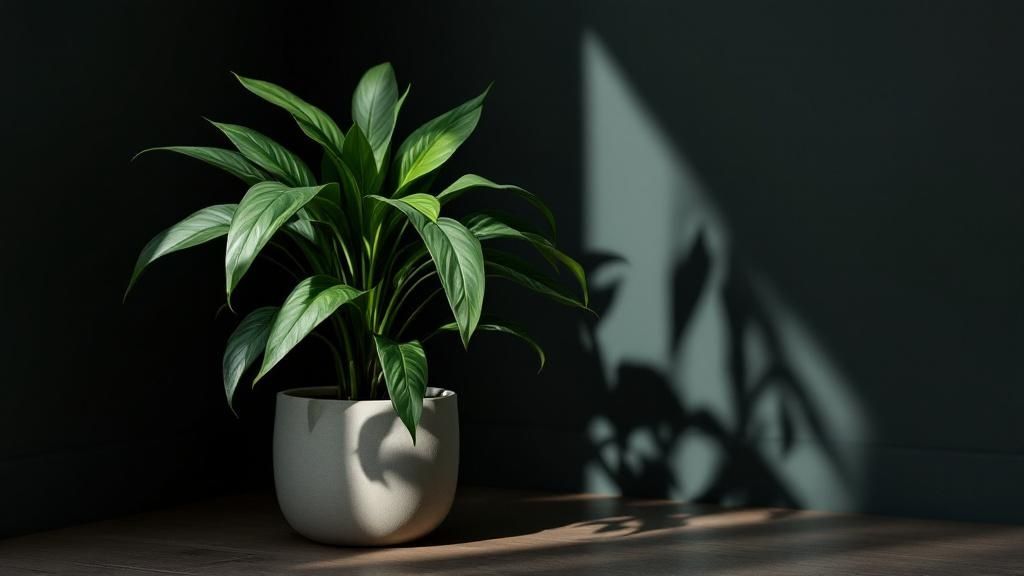
The plant's historical use in dimly lit Victorian hallways speaks volumes about its capabilities. Today, it is just as effective in modern apartments with only north-facing windows, corporate office buildings with fluorescent lighting, and the ambient interiors of restaurants or hotel corridors. Its slow-growing nature means it won't quickly outgrow its space, making it a reliable, low-effort decorative element. For more inspiration on creating a resilient green space, explore these low-maintenance garden ideas from Spruce Collective.
Why It Works for Dark Rooms
The Cast Iron Plant's success in low light is due to its highly efficient chlorophyll, which allows it to photosynthesise effectively with minimal light exposure. Its large, dark leaves provide a broad surface area to capture every available photon. This plant has adapted to survive on the forest floor beneath dense canopies, equipping it perfectly for the perpetual twilight of an indoor environment far from any window.
Key Benefit: Its most significant advantage is its near-indestructibility. The plant is exceptionally tolerant of infrequent watering, low humidity, and temperature fluctuations, making it ideal for beginners or anyone with a less-than-green thumb.
Practical Care and Implementation Tips
- Watering Wisely: This plant is far more tolerant of underwatering than overwatering. Let the soil dry out completely before you water it again, which could be every 3-6 weeks depending on conditions.
- Proper Potting: A well-draining potting mix is essential. Ensure the pot has drainage holes to prevent water from pooling at the roots, which is the fastest way to harm this otherwise hardy plant.
- Keep it Clean: Dust can accumulate on its large leaves and block light absorption. Wipe them down with a damp cloth every month or so to keep the plant breathing easily and looking its best.
- Be Patient: The Aspidistra is a notoriously slow grower. Do not be concerned if you don't see rapid new growth; its slow and steady pace is part of its low-maintenance charm.
7. Philodendron (Philodendron hederaceum)
The Heartleaf Philodendron is a quintessential houseplant, cherished for its glossy, heart-shaped leaves and incredibly forgiving nature. Its classic trailing vines cascade beautifully from hanging baskets or shelves, making it one of the best plants for dark rooms where you want to add a sense of lush, green movement. Native to the tropics of Central America and the Caribbean, this fast-growing plant is exceptionally adaptable and thrives even with minimal attention, perfect for beginners and seasoned plant parents alike.
This plant's versatility makes it a favourite in various settings. You will often see its graceful vines spilling from pots in office cubicles, adding life to low-light bathroom counters, or featured in stylish macrame plant hangers. Its ability to tolerate shade while maintaining its vibrant green colour makes it an excellent choice for adding natural texture and a pop of colour to areas far from a window. Its easy-going attitude and aesthetic appeal are key reasons it's a staple in home décor; you can explore more ways to incorporate it with these green living room ideas from Spruce Collective.
Why It Works for Dark Rooms
Philodendrons are native to the floors of tropical rainforests, where they grow under the dense canopy of larger trees and receive only filtered, dappled sunlight. This natural habitat has adapted them to photosynthesise efficiently in lower light levels. Their broad, thin leaves are designed to capture as much of the available ambient light as possible, allowing them to flourish in conditions where other plants might become leggy or fade.
Key Benefit: The Philodendron is an excellent communicator. Its leaves will tell you exactly what it needs: yellowing leaves often indicate overwatering, while small leaves and leggy stems suggest it could use a bit more light. This makes it easy for owners to adjust care routines.
Practical Care and Implementation Tips
- Watering Wisely: Let the top one to two inches of soil dry out completely before watering. It's more tolerant of being underwatered than overwatered, which can lead to root rot.
- Encourage Fullness: To prevent the vines from becoming long and sparse, pinch back the growing tips. This encourages the plant to branch out, creating a bushier, fuller appearance. You can easily root these cuttings in water and plant them back in the pot.
- Provide Support: If you prefer a climbing look over a trailing one, provide a moss pole or small trellis. The plant will readily attach its aerial roots and grow upwards, creating a stunning vertical display.
- Boost Humidity: While it tolerates average household humidity, this tropical native appreciates an occasional misting, especially during dry winter months, to keep its leaves looking their best.
Top 7 Low-Light Plant Comparison
Embrace the Green: Your Journey into Low-Light Gardening
Bringing the vibrant energy of the plant world into the more shaded corners of your home is not just possible, it's a deeply rewarding endeavour. As we've explored, a lack of brilliant, direct sunlight is by no means a barrier to cultivating a thriving indoor garden. The journey from a dim, overlooked space to a lush, green sanctuary is simply a matter of smart selection and understanding basic care principles.
We've delved into some of the most resilient and adaptable houseplants available. From the architecturally striking Snake Plant, which practically thrives on neglect, to the elegant Peace Lily that offers a visual cue when it's thirsty, there truly is a perfect green companion for every low-light scenario. The key takeaway is that success doesn't hinge on having a "green thumb," but rather on pairing the right plant with your specific environment and lifestyle. These are not just the best plants for dark rooms; they are gateways to a more confident and enjoyable plant-parenting experience.
Your Actionable Path to a Greener Home
Feeling inspired? Here are your next steps to transform those dim spaces into verdant retreats:
- Assess Your Space: Before you buy, take a moment to honestly evaluate the light in your chosen room. Is it a north-facing window with gentle, indirect light, or a hallway with only artificial lighting? Your honest assessment is the foundation of your success.
- Revisit the List: Refer back to our detailed profiles. If you're a busy professional, the ZZ Plant or Cast Iron Plant might be your ideal, low-maintenance match. If you desire a cascading, vining effect for a bookshelf, a Pothos or Heartleaf Philodendron is an excellent choice.
- Start Small: Choose one or two plants to begin your low-light gardening journey. This allows you to learn their specific rhythms and needs without feeling overwhelmed. As your confidence grows, so can your collection.
- Master the Basics: Remember the golden rule of low-light plant care: less is more. These plants generally require less water than their sun-loving counterparts. Always check the soil moisture an inch or two down before reaching for the watering can to prevent the common pitfall of overwatering.
Mastering the art of low-light gardening empowers you to redefine the limits of your home décor. It's about bringing life, colour, and a sense of calm to every corner, proving that even the most challenging spots can become focal points of natural beauty. Imagine showcasing your new Cast Iron Plant in a designer pot you won in an exclusive Spruce Collective giveaway, a reward for your budding passion. This is more than just decoration; it's an active, engaging hobby that improves air quality and boosts your well-being.
Your home is a canvas, and with the right knowledge, no area needs to be left bare. So, embrace the shadows, choose your green champion, and watch as the darkest rooms in your home begin to come alive.

